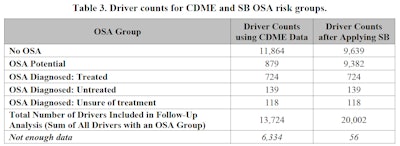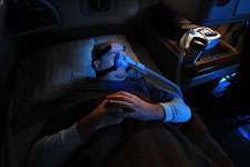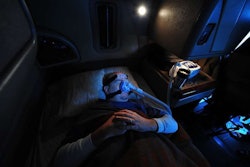Trucking news and briefs for Wednesday, Jan. 13, 2021:
 A 2020 study released by the Virginia Tech Transportation Institute found that nearly half of truck drivers are at risk for obstructive sleep apnea. This table compares drivers tested for OSA using commercial driver medical exam (CDME) data compared to the STOP-Bang (SB) sleep apnea screening assessment on the same pool of drivers.Virginia Tech Transportation Institute
A 2020 study released by the Virginia Tech Transportation Institute found that nearly half of truck drivers are at risk for obstructive sleep apnea. This table compares drivers tested for OSA using commercial driver medical exam (CDME) data compared to the STOP-Bang (SB) sleep apnea screening assessment on the same pool of drivers.Virginia Tech Transportation Institute
A 2020 study looking at the prevalence of obstructive sleep apnea (OSA) in truck drivers found that nearly half of the 20,000 observed truck drivers potentially had apnea.
The study, conducted by the Virginia Tech Transportation Institute, used the so-called "STOP-Bang" sleep apnea screening tool, which assesses a person’s snoring, tiredness, observed apneas, hypertension, body mass index (BMI), age, neck circumference and gender to determine their risk factor for sleep apnea.
Researchers analyzed data collected from a previous study of just over 20,000 truck drivers, along with medical data from these drivers’ medical exams. In the initial study, only 6.4% of the drivers were marked as potentially having OSA, while 86% were marked as having “No OSA.” The remaining drivers had already been diagnosed with OSA.
Applying the STOP-Bang assessment identified 8,503 drivers from that pool as “OSA Potential” who were formerly “No OSA” or identified as not having enough data to make an OSA determination. These drivers, combined with the 879 drivers already included in the “OSA Potential” group, totaled 9,382 drivers potentially having obstructive sleep apnea, or 46.9% of the total driver pool in the study. These drivers would then require a sleep study to determine an OSA diagnosis.
According to the study, 48.19% of surveyed drivers had no sleep apnea after applying the STOP-Bang assessment, while 3.6% had diagnosed and treated OSA.
VTTI researchers say the efficacy of the STOP-Bang assessment in screening truck drivers for OSA should be further evaluated.










